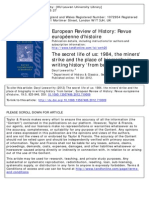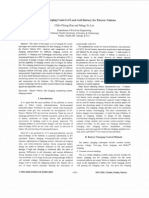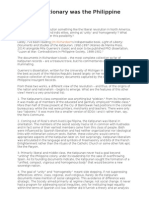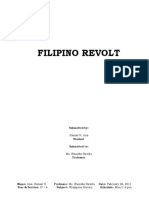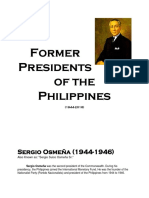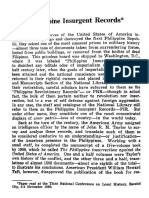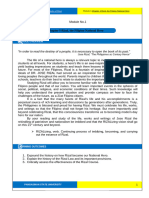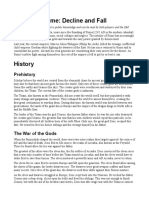0 ratings0% found this document useful (0 votes)
212 viewsHIST5
HIST5
Uploaded by
Ronally RonunoCopyright:
© All Rights Reserved
Available Formats
Download as PPTX, PDF, TXT or read online from Scribd
HIST5
HIST5
Uploaded by
Ronally Ronuno0 ratings0% found this document useful (0 votes)
212 views20 pagesOriginal Title
HIST5.pptx
Copyright
© © All Rights Reserved
Available Formats
PPTX, PDF, TXT or read online from Scribd
Share this document
Did you find this document useful?
Is this content inappropriate?
Copyright:
© All Rights Reserved
Available Formats
Download as PPTX, PDF, TXT or read online from Scribd
Download as pptx, pdf, or txt
0 ratings0% found this document useful (0 votes)
212 views20 pagesHIST5
HIST5
Uploaded by
Ronally RonunoCopyright:
© All Rights Reserved
Available Formats
Download as PPTX, PDF, TXT or read online from Scribd
Download as pptx, pdf, or txt
You are on page 1of 20
Symbolism in
Maria Clara and
Sisa
Maria Clara and Sisa, represent the
enduring sacrifices of Filipino
womanhood and nation itself
Maria Clara
- main female character of the Noli Me
Tangere
- portrayed by Rizal as the fruit of an illicit
love affair between the Spanish Franciscan
friar, Father Damaso, and a native woman,
Pia Alba, for six years the childless wife of
Captain Tiago
- molded her into something like Leonor
Rivera
- she was the typical, although not the ideal,
Filipino woman
- Shown as a young convent bred woman,
shy and awkward in spite of her innate
charms
- At 22, she is immature and unable to form
her own convictions without the approval of
her confessor or her elders
Maria Clara
- is the image of the Philippines with her
virtues and inconsistencies, a symbol made
more human characteristics of the typical 19 th
century Filipino
- she symbolizes the purity and innocence of
a sheltered native woman during the time of
Spanish occupation. She does not value
material things that were abundantly bestowed
upon her by admirers and family alike but
holds in high esteem her parents honor and
the promise she had given to her sweetheart.
Sisa
- she is the Philippines
- a typical native wife, endures her
husband's beatings and irresponsibility
and despite the abuses, she consider his
husband as her God
- described as a mother who considers
her sons her only treasure
- her features are beautiful, but are
made uncomely by later sorrow and
suffering
- she represents the Motherland, as well
as Rizals own mother and all Filipino
woman
Response to the Novels
- message conveyed by the novels made
Rizal famous
- both favorable and unfavorable response to
his eye-openers
- Rizal began receiving tributes from his
friends because of his novels
- Spanish friars reacted to the novels with
maddening anger and alarm
- in the Philippines, the effect of the novels
on the masses was enthusiastic
- few copies of the novels that cleared the customs
and reached the bookstores were sold out
- the ban against the books only served to arouse
curiosity rather than discourage their clandestine
circulation
- some readers paid the full price for taking risks;
others hesitated
- novels were widely circulated in his time
- novels were translated in different foreign languages
and native dialects to reach greater audience
- readership and acclaim of the novels is much more
extensive today and theyve perceived the novels as
renewal of mind and spirit
- Rizals message is headed by a grateful Filipino
people in a paramount concerted effort towards
progress and self-reliance
Oh, what a beautiful morning by Ambeth R.
Ocampo
the article written by todays most famous Filipino
historian Ambeth R. Ocampo on Jose Rizals death.
Simply entitled, The Death of Jose Rizal, this
historical piece by Ocampo could be deemed
refreshing and controversial, as it offers several
unpopular and unorthodox accounts of what
(presumably) transpired on the day of Rizals
execution. For one thing, it virtually proclaims that
Rizal refused to kiss the crucifix before he was
executed, thereby negating the claim of other
historians (like Zaide) that the national hero even
asked for this Catholic sacramental.
Photographer recorded Rizal martyrdom
by Jerome Aning, Philippine Daily Inquirer
- original photograph of the execution of Rizal at
Bagumbayan Park is the centerpiece of the Geronimo
Berenguer de los Reyes, Jr. (GBR) Museum in General
Trias, Cavite.
- the photograph became the center of controversy
among historians two years ago when historian Pio
Andrade questioned its authenticity.
- the GBR Foundation put an end to the controversy by
producing the original albumin print of the execution
shot taken by Manuel Arias Rodriguez, a photographer
who had a bookstore at Carrieto called Agencia
Editorial.
Manuel Arias Rodriguez,Fusilamiento de Jose Rizal,
1896
Authenticated
- the photograph was authenticated
by the foundation
- Luisa Vargas Arias, granddaughter of
Arias, personally verified and
confirmed the authenticity of the
photograph in the GBR Museum
Rare Images
- Underwood, a photographer of the American
news photo agency, captured a vivid and
touching scene of a young man saying
goodbye to his family before he marched off
to the war front with Gen. Emilio Aguinaldo
- other rare images come from various
private photographers and collectors as well
as institutions such as the Museo de Ejercito
and the Biblioteca Nacional in Spain, and the
ROYAL Photographic Society of England
Embedded Photographer
- Rodriguez is an embedded photographer. He embedded
himself among the Spanish forces and to cover events from
the Spanish offensive against Cavite, stronghold of the
revolution, in 1896 to the retreat of the Spanish forces to
Mindanao in 1898.
- He also took photos of the other troops landing in
Maragondon, Cavite, of ships shelling Filipino positions in the
provinces coast, Spanish artillery positions in Noveleta,
Kawit and Bacoor as well as the damaged Zapote Bridge,
scene of hotly contested battled that resulted in the Filipinos
defeat. Rodriguez avoided photographing blood and gore but
shot around the conflict areas enough to suggest the gravity
and ferocity of the revolution.
- He took a lot of pictures and he had a souvenir shot of
himself with Polavieja and his family on the board the
Uranus, the steamer that bought Aguinaldo and other
leaders of the revolution to their exile in Hong Kong after the
Pact of Biak-na-Bato.
- The governor general was to gain infamy for approving
Rizals execution. Using his influence and connections,
Rodriguez found himself covering in late 1897 the
negotiations for a truce between the Spanish colonial
government and the revolutionary leadership in Biak-na-Bato,
San Miguel de Mayumo, Bulacan.
- He also took a rare picture of Emilio Aguinaldo, then only 27
years old, who posed in full military regalia in his Biak-na-
Bato headquarters.
Isabelo Artacho, Baldemor Aguinlado, Severino
Delas Alas, Antonio Montenegro, Vito Belarminao
Sr. Don Pedro Paterno and Emilio Aguinlado
Generals and Colonels of the Philippine Insurrection. 1. Vito Belarmino,
Secretary of War, 2. Pantaleon Gracia - Lt.General, 3. Mariano Noriel -
Brigadier General, 4. Bautista Natividad - Brigadier General, 5. Primitivo
Artacho 6. Agapito Bonson - Colonel, 7. Salvador Estrella - Brigadier
General, 8. Captain Guillermo.
WAR OF THE PHILIPPINES . BULACAN, LUZON - Small fort or
stronghold of San Ildefonso in the immediate town of the same
name and path to San Miguel de Mayumo.
WAR OF THE PHILIPPINES. (Biac-Na-Bato, San Miguel, Bulacan, Luzon) -
Rebel Field. House of Emilio Aguinaldo, known among the
revolutionaries by the name of "Casa Presidencia" (Presidential House),
which was proclaimed the Republic of the Philippines on November 1
and the final peace agreement on the night of December 23.
Ominous Sign
- There are no known pictures taken
Aguinaldos proclamation of Philippine
Independence in Kawit, Cavite, on June
12, 1898. But the unidentified
Underwood photographer, who
apparently remained in Manila,
documented an ominous sign that
would determine the destiny of the
First Philippine Republic.
De los Reyes
- The man behind the museum and the
foundation, is a great grandson of Crisanto de
los Reyes, who was implicated in the foiled
18972 mutiny of Filipino soldiers serving at
Fort San Felipe Neri in Cavite.
- for supporting the mutinees Crisanto and
our other colleagues were exiled to Cartagena
in southern Spain, where they served 10-year
prison terms
- three priests involved in the mutiny suffered
a worse fate; the GomBurZa were garrotted
You might also like
- Short Course On Philippine Society and RevolutionDocument86 pagesShort Course On Philippine Society and RevolutionCyan Koon100% (1)
- TAGUIGDocument9 pagesTAGUIGKael Echavez OpogNo ratings yet
- The Secret Life of Us, Writing History From Below in The Miners' Strike 1984 - 85Document23 pagesThe Secret Life of Us, Writing History From Below in The Miners' Strike 1984 - 85hannekoningsNo ratings yet
- Blitz75Manual MaybeDocument80 pagesBlitz75Manual Maybepaul2xsNo ratings yet
- Chanakya's Chant Book ReviewDocument4 pagesChanakya's Chant Book ReviewIshaan BanerjeeNo ratings yet
- "The Need To Forget," by Yehuda ElkanaDocument3 pages"The Need To Forget," by Yehuda Elkanarpmackey3334No ratings yet
- Japanese Occupation PeriodDocument16 pagesJapanese Occupation Periodmarissa labatosNo ratings yet
- CHAPTER 12 - The Philippines Under The American RuleDocument72 pagesCHAPTER 12 - The Philippines Under The American RuleCONCORDIA RAFAEL IVAN100% (1)
- Philippine Military History - ROTC - Activity #2Document10 pagesPhilippine Military History - ROTC - Activity #2Dark SideNo ratings yet
- Filipino People of Spanish AncestryDocument7 pagesFilipino People of Spanish AncestryLinas KondratasNo ratings yet
- A Energy Price ProcessesDocument5 pagesA Energy Price ProcessesEmily7959No ratings yet
- Elite Rule in The PhilippinesDocument8 pagesElite Rule in The PhilippinesDavid Michael San JuanNo ratings yet
- Sources of Philippine SurnamesDocument53 pagesSources of Philippine SurnamesJuliana Legarte100% (1)
- Ancillary Service Procurement Plan 2011Document63 pagesAncillary Service Procurement Plan 2011Raphael Sumalinog100% (1)
- History of RotcDocument2 pagesHistory of RotcKenzii LopezNo ratings yet
- Understanding Energy PricingDocument18 pagesUnderstanding Energy Pricingdhanusiya balamuruganNo ratings yet
- Wholesale Electricity Spot Market 03.26.16Document186 pagesWholesale Electricity Spot Market 03.26.16Kevin CabanteNo ratings yet
- Utility Pricing ModelsDocument45 pagesUtility Pricing ModelsMatthew Rees100% (1)
- Final Exam Reviewer in Ged 103Document4 pagesFinal Exam Reviewer in Ged 103Sherlene Antenor SolisNo ratings yet
- A Study of Charging Control of Lead-Acid Battery For Electric VehiclesDocument6 pagesA Study of Charging Control of Lead-Acid Battery For Electric VehicleschethanNo ratings yet
- How Revolutionary Was The Philippine RevolutionDocument4 pagesHow Revolutionary Was The Philippine RevolutionFJ MacaleNo ratings yet
- Cavity Mutiny - Checklist of DocumentsDocument71 pagesCavity Mutiny - Checklist of Documentskarl IgniciaNo ratings yet
- Personal Profile in ResumeDocument8 pagesPersonal Profile in Resumevtdvkkjbf100% (2)
- Electricity Market DesignDocument44 pagesElectricity Market Designacandemor8489No ratings yet
- Comparative AnalysisDocument14 pagesComparative AnalysislorriejaneNo ratings yet
- "Losing You, Keeping You" - A Tribute To The Life and Exciting Times of 'BOSSMAN' Horacio R. Morales, Jr.Document74 pages"Losing You, Keeping You" - A Tribute To The Life and Exciting Times of 'BOSSMAN' Horacio R. Morales, Jr.laligaNo ratings yet
- Tagalogs Bacoor Bay: History of CaviteDocument5 pagesTagalogs Bacoor Bay: History of CaviteJP NielesNo ratings yet
- Historical Timeline of Philippine LiteratureDocument6 pagesHistorical Timeline of Philippine Literaturejoei_velascoNo ratings yet
- The Moro Problem (1913) Najeeb SaleebyDocument31 pagesThe Moro Problem (1913) Najeeb SaleebyAlgamar_LatiphNo ratings yet
- The Social Cancer by Rizal, José, 1861-1896Document362 pagesThe Social Cancer by Rizal, José, 1861-1896Gutenberg.org100% (2)
- Land Reform Essay 2Document3 pagesLand Reform Essay 2api-2540981770% (1)
- The Rajahnate of CebuDocument4 pagesThe Rajahnate of CebuIcas PhilsNo ratings yet
- Ivor A. Stevens: Soldier, Politician, Businessman, and Family Man: The Man, His Times, and the Politics of St. Kitts–NevisFrom EverandIvor A. Stevens: Soldier, Politician, Businessman, and Family Man: The Man, His Times, and the Politics of St. Kitts–NevisNo ratings yet
- Basilan Electric Cooeprative, Inc. (Baselco) : Supply - Demand Profile (MW)Document2 pagesBasilan Electric Cooeprative, Inc. (Baselco) : Supply - Demand Profile (MW)Drw ArcyNo ratings yet
- Lecture 1 Economic History UC3MDocument76 pagesLecture 1 Economic History UC3MAlberto GuemesNo ratings yet
- Difference Between Enchanted Kingdom and Disneyland Park...Document3 pagesDifference Between Enchanted Kingdom and Disneyland Park...Rafaiza ManoNo ratings yet
- Report On NSC 2019Document10 pagesReport On NSC 2019Viper VenomNo ratings yet
- The Chernobyl Nuclear DisasterDocument8 pagesThe Chernobyl Nuclear DisasterDaniel PonceNo ratings yet
- Filipino Revolt: Submitted byDocument7 pagesFilipino Revolt: Submitted byJyuKyuNo ratings yet
- Phil Com Sat vs. Globe TelecomDocument7 pagesPhil Com Sat vs. Globe Telecomcmv mendozaNo ratings yet
- Former Presidents (1944-2016)Document20 pagesFormer Presidents (1944-2016)rose llarNo ratings yet
- History of The Philippine Islands by Morga, Antonio De, 1559-1636Document257 pagesHistory of The Philippine Islands by Morga, Antonio De, 1559-1636Gutenberg.orgNo ratings yet
- Topic: Rizal: HistoryDocument5 pagesTopic: Rizal: HistoryJohn JovonovichNo ratings yet
- Renewable Energy Towards A Sustainable Power Supply in The Nigerian Power Industry: Covenant University As A CasestudyDocument9 pagesRenewable Energy Towards A Sustainable Power Supply in The Nigerian Power Industry: Covenant University As A CasestudyIAEME PublicationNo ratings yet
- For Land OwnershipDocument12 pagesFor Land OwnershipFelimar CalaNo ratings yet
- Baseco Proc1 HTMLDocument19 pagesBaseco Proc1 HTMLadrianvillNo ratings yet
- Juan Luna & Fernando AmorsoloDocument24 pagesJuan Luna & Fernando AmorsoloFreya GeslaniNo ratings yet
- Who Got Their Pork Barrel Releases in 2012Document9 pagesWho Got Their Pork Barrel Releases in 2012Patrick ManahanNo ratings yet
- Bataan FactsDocument3 pagesBataan FactsGes HuNo ratings yet
- Independence DayDocument4 pagesIndependence DayEmmalyn TabilogNo ratings yet
- Module. Phil History 3 5 WeeksDocument4 pagesModule. Phil History 3 5 WeeksJohn Vincent D. ReyesNo ratings yet
- Praymer On House Bill 7787 P750 National Minimum Wage BillDocument20 pagesPraymer On House Bill 7787 P750 National Minimum Wage BillRobert Dela CruzNo ratings yet
- LAWS & EXECUTIVE ISSUANCES (1900-2014) : ENERGY Part3Document794 pagesLAWS & EXECUTIVE ISSUANCES (1900-2014) : ENERGY Part3LIRMD-Information Service DevelopmentNo ratings yet
- The Spaniards As Colonial MastersDocument45 pagesThe Spaniards As Colonial MastersSaymon Casilang SarmientoNo ratings yet
- AgrarianDocument12 pagesAgrarianlawrence aibagNo ratings yet
- Florida's Energy Future - Bill McCollum For GovernorDocument5 pagesFlorida's Energy Future - Bill McCollum For GovernorBill McCollumNo ratings yet
- Amor PatrioDocument11 pagesAmor PatrioLeanne Joy AnguloNo ratings yet
- PGC2016Edition (ResolutionNo22Seriesof2016)Document180 pagesPGC2016Edition (ResolutionNo22Seriesof2016)Nemanja KomatinovicNo ratings yet
- Calumpit BulacanDocument12 pagesCalumpit BulacanLisa MarshNo ratings yet
- 1 RL Memory and Amnesia by OcampoDocument10 pages1 RL Memory and Amnesia by Ocampobugtongshana0No ratings yet
- Janice CastroDocument64 pagesJanice CastroHelmer PascualNo ratings yet
- Part 2Document18 pagesPart 2charlea TanalaNo ratings yet
- GE 9 SG 1 1st Sem AY 2024 2025 1Document8 pagesGE 9 SG 1 1st Sem AY 2024 2025 1Racquel M. ReyesNo ratings yet
- A H Wratislaw - Sixty Folk Tales From Exclusively Slavonic SourcesDocument199 pagesA H Wratislaw - Sixty Folk Tales From Exclusively Slavonic SourcesGogi Nareklishvili100% (1)
- Olav Hofland - MA Thesis - Cooking Towards Communism - FINAL PDFDocument97 pagesOlav Hofland - MA Thesis - Cooking Towards Communism - FINAL PDFkarl hoffmannNo ratings yet
- BECC Catalogue 2012 ProvidedDocument20 pagesBECC Catalogue 2012 ProvidedModelFlags100% (2)
- Tangail GMDocument30 pagesTangail GMbibahabondhonitNo ratings yet
- 1907 Pistol TrialsDocument28 pages1907 Pistol TrialsonatbrossNo ratings yet
- Thesis WVDocument9 pagesThesis WVfjmayw0n100% (2)
- GM Fu WorkbookDocument30 pagesGM Fu WorkbookSteve Zissou100% (6)
- ZXXCKV LKZ DKCPSJD VDocument36 pagesZXXCKV LKZ DKCPSJD VBonnie WellsNo ratings yet
- KatipuneraDocument1 pageKatipuneraKyle AbiogNo ratings yet
- Carol Rose Stephen Greer AlienHoaxDocument8 pagesCarol Rose Stephen Greer AlienHoaxJoe Belton100% (1)
- JURNAL - Anton Budi PranataDocument10 pagesJURNAL - Anton Budi Pranatarizkasarii10No ratings yet
- Sector 4 Extraction 2014 1080p-720p BluRay x264 YIFY EngDocument53 pagesSector 4 Extraction 2014 1080p-720p BluRay x264 YIFY EngbefaceNo ratings yet
- Oshkosh - FMTVDocument20 pagesOshkosh - FMTVUsNdaomanu100% (2)
- 40K Unique Mission IdeasDocument2 pages40K Unique Mission IdeasAkrim0No ratings yet
- Ancient Roman D&DDocument37 pagesAncient Roman D&DGuy IncognitoNo ratings yet
- UNITED STATES 1942-43: Parachute Support List List OneDocument1 pageUNITED STATES 1942-43: Parachute Support List List OnejoseNo ratings yet
- The United States in Northeastern Syria: Geopolitical Strategy Cannot Ignore Local RealityDocument17 pagesThe United States in Northeastern Syria: Geopolitical Strategy Cannot Ignore Local RealityHoover InstitutionNo ratings yet
- Frederick Jackson Turners Thesis Argued That Americas Frontier QuizletDocument7 pagesFrederick Jackson Turners Thesis Argued That Americas Frontier Quizletbufukegojaf2100% (1)
- BACOORDocument3 pagesBACOORJohn Michael EstilloreNo ratings yet
- Military Trader - October 2019 PDFDocument58 pagesMilitary Trader - October 2019 PDFAnonymous wZZqdgBMRqNo ratings yet
- KenpoDocument2 pagesKenpoTroy KayeNo ratings yet
- Istvaanian SourcebookDocument44 pagesIstvaanian Sourcebookchris100% (2)
- Soyinka Death in The DawnDocument2 pagesSoyinka Death in The DawnRakhi P NairNo ratings yet
- Semester 3Document19 pagesSemester 3Susan TactayNo ratings yet
- Sesson 2 - 3 - HomeworkDocument3 pagesSesson 2 - 3 - HomeworkHồ Cường Kaizen83% (6)
- Complete Latin American Revolutionaries and The Arab World From The Suez Canal To The Arab Spring Federico Vélez PDF For All ChaptersDocument62 pagesComplete Latin American Revolutionaries and The Arab World From The Suez Canal To The Arab Spring Federico Vélez PDF For All Chaptersipolyinimu100% (4)
- Bvsmunvi - Unsc Study GuideDocument21 pagesBvsmunvi - Unsc Study GuideM Hunain Raza MHRNo ratings yet


